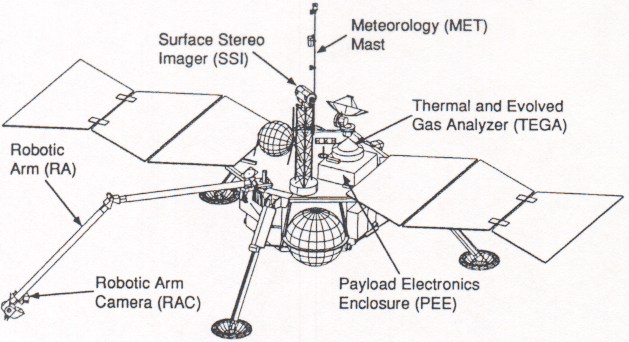
This Mars Surveyor lander will reach the Red Planet in December 1999.
Sometime in December 1999, as the world prepares for one of the biggest New Year's celebrations of all time, the fourth U.S. Mars lander will touch down near the martian south polar cap.
NASA has two spacecraft in its Mars Surveyor '98 series. An orbiter will be launched in December 1998. The orbiter carries a replacement of Mars Observer's Pressure Modulator Infrared Radiometer (PMIRR), plus a color camera system built by TES team member Michael Malin (Malin Space Science Systems, San Diego, Calif.; See WWW site at http://barsoom.msss.com/).
The other spacecraft is a lander. On October 30, 1995, NASA announced the team that would supply instruments and science objectives for the lander. NASA chose a team put together by David Paige of the University of California, Los Angeles (UCLA). The lander, dubbed Mars Volatile and Climate Surveyor (MVACS), will launch in January 1999 and reach the Red Planet in December 1999. MVACS, as illustrated above, will land somewhere on or near the South Polar Layered Deposits-- an area of seasonal ice cap formation. The Layered Deposits are thought to consist of dust and ice. They exhibit layering which scientists think may be connected to major climate changes in the martian past. The MVACS lander is presently slated to land in the late Southern Spring season around latitude 71 S, longitude 210 W. The "volatiles" Paige and his team will study are water and carbon dioxide.
The mission has some strong Arizona connections: the camera, known as Surface Stereo Imager (SSI) will be put together by Peter Smith's team-- the same University of Arizona (UA) group that is running the camera system for Mars Pathfinder. Arizona State University professor Ronald Greeley is on Smith's team. Another MVACS instrument, Thermal and Evolved Gas Analyzer (TEGA) is headed by William Boynton of UA; it will look at the water, carbon dioxide, and water-bearing minerals at the landing site.
For more information, visit David Paige's MVACS World Wide Web site at http://thesun.ess.ucla.edu/.